#Tabarzin Axes
Explore tagged Tumblr posts
Text
In reaction to this post, @irlactualwizard wrote:
This is beautiful. On the note about maces and the like, they're traditionally horseback weaponry. I'm unsure of the usefulness or practicality of a dagger tucked away in a weapon primarily used from 'higher ground' or where CQC wouldn't be common. I mean, fall off the horse, drop the mace and draw the saber or katar. Although, redundancy is what keeps humans alive. It does strike me as odd that they wouldn't have shoved an extra weapon in just for the niche.
That notion of dropping the mace then drawing something else with longer (or for really close quarters, shorter) reach is something which may well have happened, though not just because it was an exclusively cavalry weapon. All the other weapons were also used from horseback, and in one instance its original Indo-Persian name is pretty specific about equestrian origins.
The zaghnal, that wicked pick-axe thing...
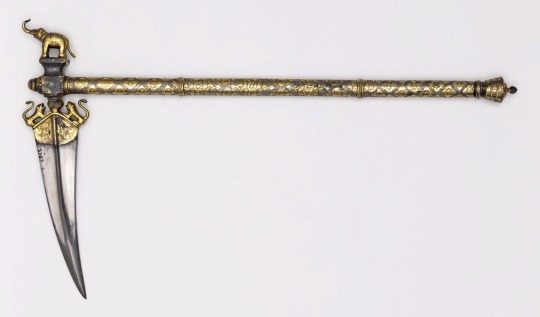
(yup, there's a dagger...)
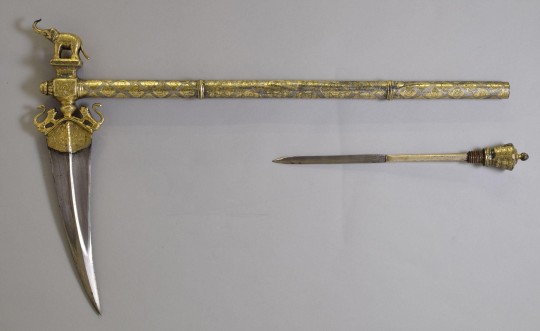
...has a European equivalent called a "horseman's pick" and supposedly copied from Ottoman weapons which would have been zaghnal-shaped; this one is Polish or Hungarian...

The hatchet-knife bhuj was - per Wikipedia, Bygone Blades and Oriental Arms - a popular weapon with the Gujarati and Sindhi cavalry, who also wore a distinctive style of full armour...
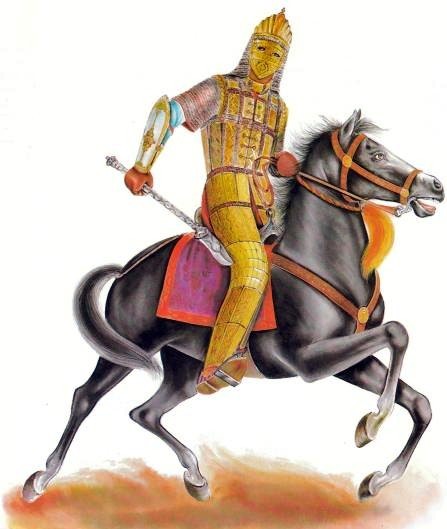
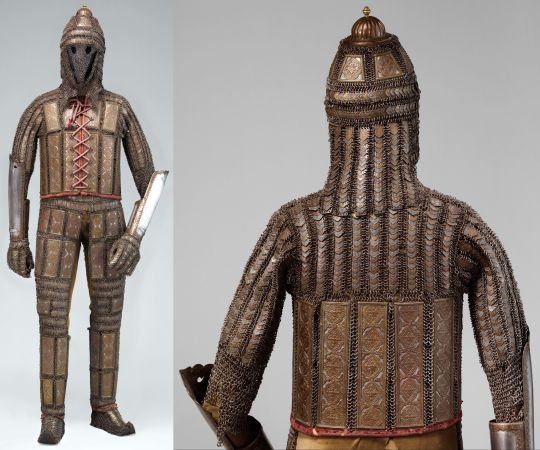

(yup, there's a dagger)

(This time there's a gun, and probably a dagger too because why not?)

Most conclusively, the proper name for Indo-Persian battleaxes is tabar / tabarzin, which means "saddle-axe".
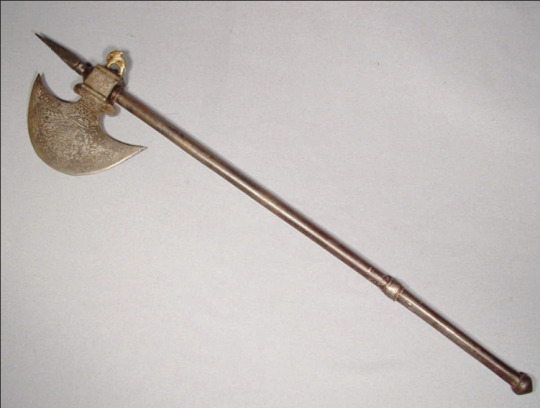
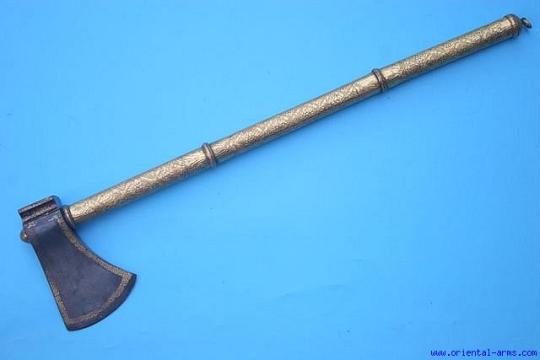
These included some of the few real-life examples of double-headed battleaxes (with daggers, but of course...)


Though popular in fantasy art, IRL usual practice was to have an axe on one side and something different like a hammer or pick on the other side in case the axe wasn't effective enough against whatever kind of armour the opponent was wearing.
And of course even single-headed axes often had the usual dagger tucked away.

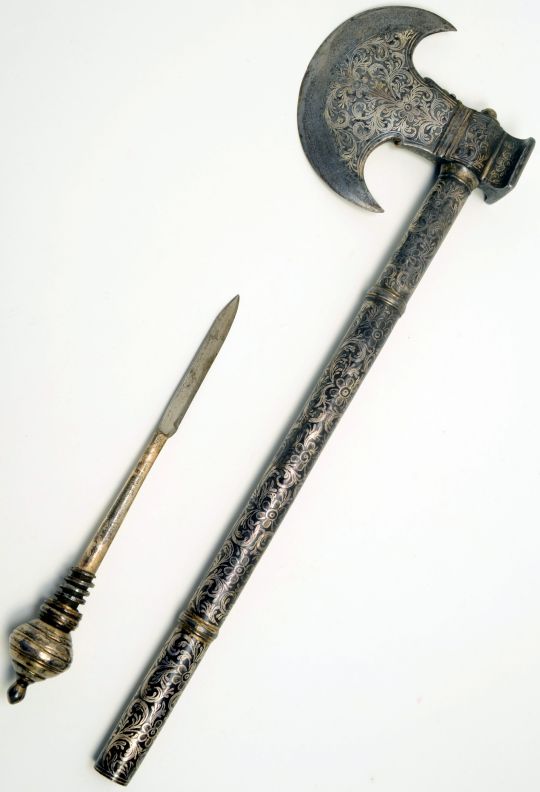
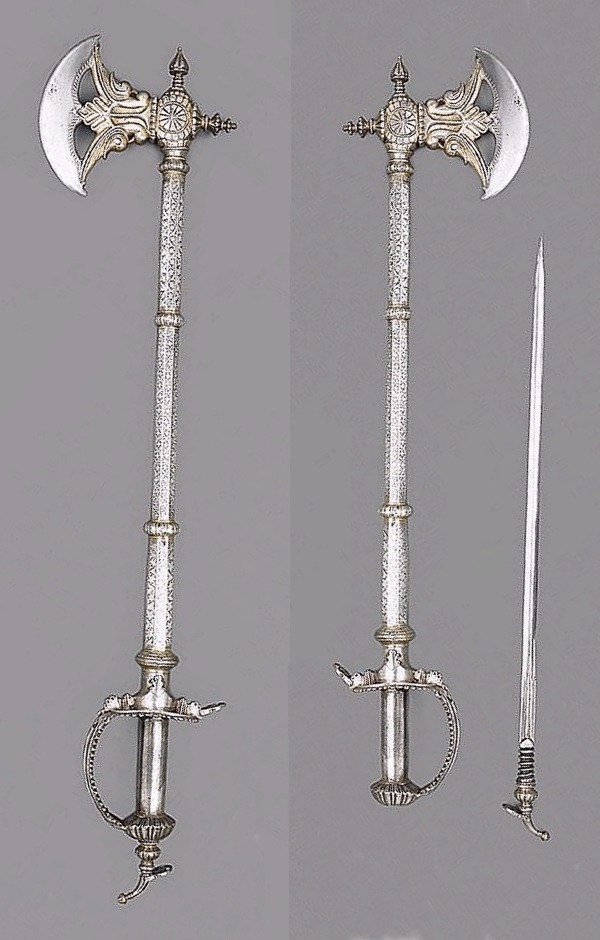
Here's yet another with a sword-hilt (also possibly a dagger) and a built-in matchlock gun...

And here's one where some warrior just couldn't make up his mind.

Here's a mace with a similar (khanda broadsword) hilt:

I took a close look at various mace-pics I've posted (here and here), something I should have done before, then searched further on-line, and I'm starting to think they had no daggers because mostly their hafts were solid rather than hollow...

Thanks go to @irlactualwizard for prompting me to track down an answer to my own question - though I'll be waiting for someone who knows far more about Indian weapons to correct me. :-P
Finally, here's a display case showing three more maces, a couple of the double- (here triple-) -bladed daggers called haladie, and a few examples of what Indian weaponsmiths could do with the basic concept of a sword blade...

...including making use of a European hilt, top row second left. Its blade may have been mounted on an Indian khanda or talwar hilt, which happened often enough to create a whole class of "firangi" (Frankish) swords.
There are many more pics on my blog and elsewhere. Once again, for fantasy edged-weapon inspirations, India is a great place to start...
:->
160 notes
·
View notes
Text
What sort would you choose? Tabarzin? Dagger axe? Inverse crescent blade? Double headed?
I'm a fan of the katar/axe combo
i deserve a battle axe i think
37 notes
·
View notes
Photo

Priti Reference
Character Reference for Priti, an elected member of the Amba Sanctuary Council. A powerful warrior and military strategist, she is ready to lead the next generation of warriors to a brighter future! She wears armor based on pangolin scale and char-aina/mirror armor that she wears over her sari! The armor detailing took forever my goodness but I'm happy with how it turned out!
Posted using PostyBirb
#priti#armor#tabarzin#char-aina#mirror armor#mirror#sari#scale mail#axe#battleaxe#greataxe#detailing#tiger#bengal tiger#stripes#warrior#furry#furry oc#furry art
9 notes
·
View notes
Text
Gada (Mace) ladder style workout
Gada (Mace) ladder style workout that includes Indian Clubs, Persian Meels and Tabarzin Axes.
Gada (Mace) ladder style workout
This video is based on a Gada (Mace) ladder-style workout incorporating Indian Clubs, Persian Meels and Tabarzin Axes.
Gada (Mace) ladder style workout – DRUMBEAT
I am using a drumbeat in the background which is recorded at 60 beats per minute, and the idea is to keep up with the drumbeat regardless of equipment be it Gada (mace), Indian Clubs, Tabarzin Axes or…
View On WordPress
4 notes
·
View notes
Text
Pg. 2: Himnad Crusher’s Haubergeon

The time is come for the annals of high fashion to embrace a… wilder side of things. Descending from the untamed environs of Abalathia’s Spine, the armor of the Himnad Crusher becomes the gear of choice for Warriors. The crystalline spikes upon the pauldron and greaves protect the wearer as they charge headlong through a snow-capped battlefield, and their skulled armet brings a deathly visage, making one’s eyes glow a deep bluish-violet when the Inner Beast is set forth.
The Warrior’s arm may not look extravagant compared to other weapons in this line, but this is no ordinary axe. This Tabarzin - dubbed “Skadi” - is forged in an alloy of Himvat and Cloud Mythril, providing its sleek and permafrosted finish. The very strength of the northern mountains flows through the weapon in the heat of battle, cloaking the Warrior in an icy aura that augments their blows with arctic savagery.
Become like the mountain king as you don the Himnad Crusher’s Haubergeon. By keeping yourself warm and leaving your foes and friends alike gasping in fear and awe, primal fury has never looked - or felt - so good.
#thiji higuri#Higuri Regalia#pib catalogue#Himvat Gallery#ff14 FFXIV#fashion#high fashion#male hyur#ffxiv hyur#Abalathia's Spine#ffxiv warrior#haute couture#couture#balmung rp#ffxiv balmung#ffxiv rp#crystal rp#FFXIV crystal
4 notes
·
View notes
Link
Rating: Teen And Up Audiences Warnings: No Archive Warnings Apply Relationships: Blake Belladonna/Yang Xiao Long, Lie Ren/Nora Valkyrie Characters: Blake Belladonna, Nora Valkyrie, Lie Ren, Yang Xiao Long, Mercury Black, Emerald Sustrai, Cinder Fall Additional Tags: Fluff, Space Hulk, By Way of Left 4 Dead Series: Part 9 of Game Nights at Beacon Academy
+++ BEGIN TRANSMISSION. SECURITY LEVEL ALPHA-NINER-SECUNDUS. +++
+ASTRAL KNIGHTS DEPLOYING+ StrawberrySlugger is a Gunnery Sergeant of the Marine Order. MewMew is a Paladin of Martel Cathedral. BlackCat13 is a Techknight of the Augmetic Order. LotusAxeaxein is a Grenadier of the Order of the Cog & Giblet. SicaSon is a Knight of the Order of the Axe. HotterThanU is a Knight of the Order of the Axe.
+DESTINATION+ The Astral Derelict Wailing of Widows
+MISSION OBJECTIVES+ Download Data Cores from Command & Control. Return to deployment zone for extraction.
+THOUGHT FOR THE DAY+ It is better to live one day as a lion, then ten thousand years as a mouse.
+++END TRANSMISSION+++
4 notes
·
View notes
Text
Wall decorative frame of weapons featuring gold damascened koftgari shield in center and gold koftgari helmet alomg with silver koftgari swords in small medium and large size.
Warrior tabarzin crescent axes on either sides with two tiger knives kataars with silver damascened on it.
#wallartdecor #wallart #weapondecor #gold #silver
#shamshir #kilij #talwar #shield #dhal #kataar #tigerknife #axe #tabarzin #damascene #koftgari #frame #wallart #Sikh #ornate #oriental #swordartonline #ottoman #helmet #kufic #arabic
instagram
0 notes
Photo

🔷Ancient Iranian Metal Arts. Two Copper ceremonial axe heads from Kerman, Khenaman cemetery, Late 3rd millennium, ca 2000 B.C., ceremonial or ritual axes in Iran are called Tabarzin, a word that before Safavid ere were given to a battle axe fastened to the sides of a war horse saddle. These copper-arsenic axe head are comparable to Bactrian/ Margianian, and Lorestan axe heads. Brutish museum. Photo from John Curtis book Ancient Persia, 2008. #AncientIranianMetalworks#abdorezamajdi #IranianBrassAge#Kerman#chalcolithiciran # 🔴تيغه ى تبر مسى( آلياژ مس و ارسنيك) از گورستان باستانى خنامان ، كرمان، اواخر هزاره ى سوم ق.م.، حدود ٤٠٠٠ سال پيش، موزه ى لندن. اين تبرهاى آيينى را مى توانيم با نمونه هاى بلخ و مرو، و لرستان مقايسه كنيم. عكس از كتاب جان كرتيس Ancient Persia. (at Darakeh, Tehran, Iran)
0 notes
Note
Do you know of any information on traditional Kazakh swords and bladed weapons? Beyond just the typical curved sabre common across the continent?
Besides swords, they’d have carried bows, lances and daggers, probably of straight or curved kindjal type...

...as well as maces and axes (good cavalry weapons).

The couple of (lightweight) books I have about steppe nomads suggest their swords didn’t have the broad double-edged ‘yelman’ point of the Turkish kilij and were less curved than the Persian shamshir.


This sounds as if they were an early form of Cossack (Kazakh?) shashka.
I found an image on this website which confirms my guess; the exhibit includes small cavalry axes which the Kazakhs called aybalta; the Indo-Persian word is tabar or tabarzin:

Here are several more, photographed in 1899...

...and here’s a Kazakh warrior holding one, with an unstrung bow slung at his back and a matchlock musket propped alongside him. The blade-like thing under the axe-head is indeed a blade, meant to discourage grabby hands.

However there’s another display case on the same website which shows a sword that’s very like a typical shamshir...

...and a recent archeological find looks like this...

...though I think the quoted 7th Cent. BC-4th Cent. AD dating is far too early for that shape of sword and hilt.
IMO it’s a later sword lost or buried in an area now known for earlier artefacts, and someone unaware of how swords changed over centuries has assumed that it belongs to the same time-period as the majority of finds on the site.
As for how swords of the shamshir / kilij style got to Kazakhstan when the local style was noticeably different, I’d guess at “regional variations or war booty” and leave it there.
Here’s another page, originally in Russian (?), which has an overview of Kazakh weapons with some almost-familiar names: semser (shamshir), kylysh (kilij) and gurzi (gurz / spiked mace).
However in some languages “kilij” just means “sword” and “balta” means “axe” rather than a particular type of each. It was the same in the European Middle Ages, where the word for sword was all too often “sword”. All of which is rather a burr under the saddle of those who like their lists of weapons to look neat... :->
Anyway, I hope this helps a bit to answer your question.
56 notes
·
View notes
Text
Tabarzin Axes Body Cross
Indian Clubs | Tabarzin Axes Body Cross upward & downward movements.
Tabarzin Axes Body Cross
Tabarzin Axes (weight 2.5lbs each, length 24″ inches featuring an off centre balance point).
Exploring upward & downward body cross movements
Body cross movements are swung onto planes, the frontal plane and the sagittal plane.
Tabarzin Axes Body Cross – Downward
The downward body cross movements are started with the axes held parallel overhead, from there the axes are…
View On WordPress
0 notes
Text
Tabarzin Battle Axes
Talking Tabarzin Battle Axes and why I made them. They are made from West Australian hardwood called JARRAH, weigh 2lbs 8ozs each and are 24" long.
Tabarzin Battle Axes
These wooden replica Tabarzin Battle Axes are made from West Australian hardwood called JARRAH. They weigh 2lbs 8ozs each and are 24″ long.
Inspiration to make Tabarzin Battle Axes
I was inspired to make the Tabarzin Battle Axes after I saw the front cover of Health & Strength (02 Nov 1907) magazine that featured Tom Burrows the Endurance Club Swinging Champion who was 39…
View On WordPress
0 notes